The Hudson Hornet has a fascinating history and – to look at the car – you wouldn’t think it was the dominating make in the early years of NASCAR racing. 1954 would be the last year of the so-called “step down” Hornets, where the floorboards were recessed below the entry point. And just a few months later, the Hudson nameplate would wind down as the company became part of the then-new American Motors. This ’54 Hornet Special has only recently been made roadworthy again and – while it still needs more attention – it’s quite a stunning machine just the way it is. Located in Omaha, Nebraska and here on eBay, the bidding is up to $7,001 but the reserve has not yet been met. Thank you, Larry D, for finding such a cool car for us here at Barn Finds!
Full-size Hudson’s were restyled for 1954 with new features like a one-piece curved windshield, revised sheet metal from the beltline down, and a powerful flathead-six engine. The model year would bring the introduction of Hudson’s last new model, the Hornet Special, which was a trimmed down version of the car (but it certainly didn’t look that way). With Hornet Special badging and less exterior brightwork, the car could be had for $115-140 less than a regular Hornet. In spite of the changes, sales of the brand continued to be lackluster with fewer than 25,000 Hornets being built that year. The merger with Nash-Kelvinator would take shortly thereafter, and thus AMC was born.
The seller’s ’54 Hornet Special is one of the better described cars we’ve seen latterly. i.e., this is how to sell a car. We’re told the Hudson was tucked away in a garage in 1965 due to a transmission issue and apparently stayed there for 55 or so years. The seller had it totally rebuilt and reinstalled, a $2,200 expense in itself. The Hornet Special came with a 308 cubic inch six-cylinder that was rated at 160 hp with a 2-barrel carburetor. The engine turned easily when the seller first tried it, so a series of repairs were begun. This included a new 6-volt battery, radiator, water pump and thermostat, new hoses and belts, and a complete tune-up. The gas tank was dropped, cleaned and dipped and new fuel lines installed. The brakes were all completely redone, but a new muffler wouldn’t be a bad idea.
Exterior-wise, there seems to be no rust anywhere on the body or frame. The car was likely painted red to begin with but changed to gold later. But the job was done superficially in that the door jams and under the hood and trunk were not repainted/changed. What’s there looks good from a distance, but its either fading or chipping away in quite a few places, especially the roof. The script “Golden Goose” was painted on the rear deck and probably had some special meaning to the owner at the time.
The buyer could leave the Hudson alone and go the patina route or restore the body to original specifications. There is a “swamp cooler” attached by one of the rear windows, which at first looked like some sort of rocket! It does not come with the car but it’s available at extra cost, although the seller doesn’t say how much.
Inside the automobile presents very well for its 67 years. The seats look to be solid, covered in vintage plaid with cloth panels and vinyl trimmed with hog rings. The headliner is original and has no tears or sagging. The door trim panels have some wear but are quite functional. Not a lot needs doing here except maybe the seals where the windows roll up and down. The odometer says 77,600 which is likely correct given that the car was only on the road for 11 years.
The seller tells us this a good running car and cruises nicely, but the engine seals may need attention as the car leaks a little after it’s been warmed up and run. I hope the new owner will decide to restore this car back to its original form and not customize it, turning it into a hot rod or rat rod which has happened to a lot of these 1950s cruisers. This would be grand machine to take to shows without breaking the bank. Hagerty assesses top resale value to be not more than $25,000.
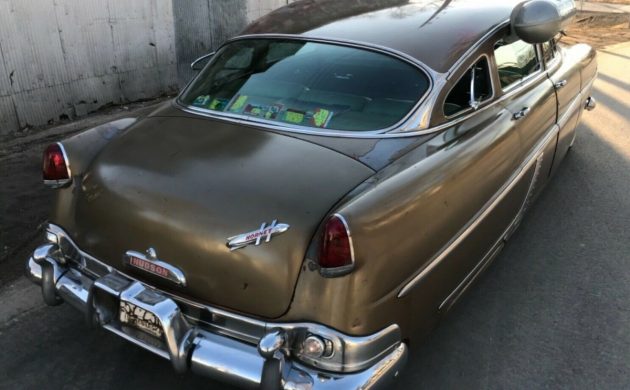

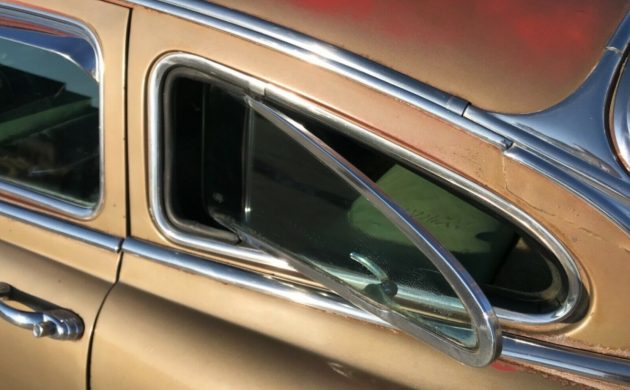
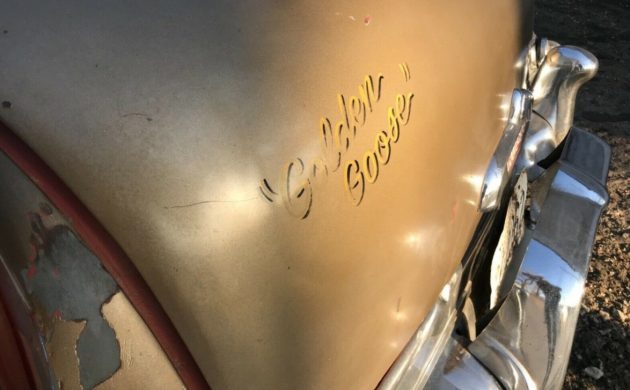
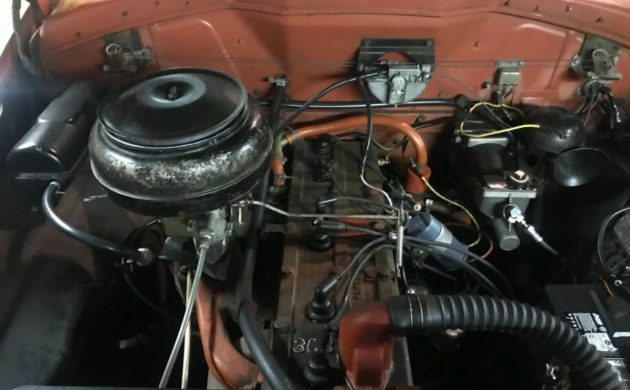
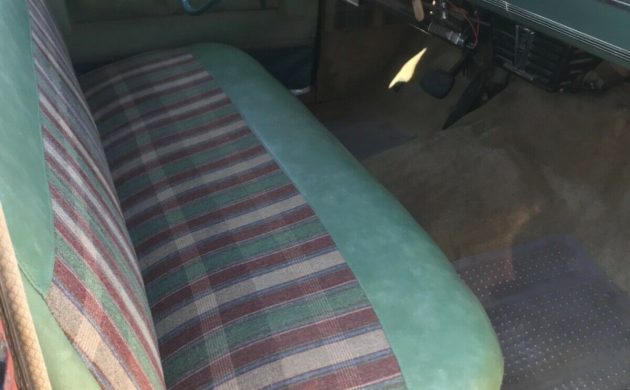


Those of us born in this time period should look as good as this bad boy does. I’d drive it home then do a repaint (same color), replete the chrome, rebuild the engine reupholster it and then go put some more miles on it with those cutouts open..
C’mon, Powerball ticket!! There’s a bunch of great cars this week we need for the garage..
*RePAINT not replete
Re-PLATE, yah.
Really fat-fingered this one today didn’t I!?!
Yes, rePLATE!! Geesh! Thank you, Chawlers.
No mention of the swamp cooler. Sold separately. Anyone know if the swamp coolers really worked?
Yah – BUT since they were filled with water or crushed ice and wind power from outside to inside, using one introduced moisture into the car. Where moisture dwells so does rot and mold.
I would love to install an aftermarket a/c unit. Might take a bit of engineering but, IMHO, would be worth it. At my age, I love my creature comforts.
Helped install a Vintage Air system a few years ago in a friend’s Hornet. Fit neatly under the dash. The evaporator and fan are built into a black housing that was relatively easy to install with little modification. It also didn’t interfere with the stock Hudson heater. The lines ran thru the firewall above the driver’s feet and the compressor between the battery and engine block. Was driven by a single wide belt. The compressor is available with the 5/8″ belt pulley like stock Hudson.
If you live in a low humidity area they do work pretty well at speed. I had one on my ’46 Ford Fat Fender when I showed it in the desert southwest and it was fine.
Had a lot of fun with kids and even some older folk who had never seen one. Told them it was a rocket launcher or a bazooka or sometimes a toilet paper dispenser. Lotsa grins!
They do work, but you need to be in a dry climate. Denver’s humidity level in the summer is about 3%. They work there.
Swamp Coolers: They help in Arizona, Utah, Nevada and parts of Southern California. Elsewhere they are either not needed or the air is too humid to allow evaporation, and therefore cooling.
I live in Chicago. I go to small neighbor hood car shows. I’ve seen a few swamp coolers on 50s cars.guess if you got it show it?
Curious they called it a swamp cooler and not a desert cooler.
IIRC, Desert Cooler was the name of a company that made a (5 gal?) burlap bag type canteen that you’d soak then fill with water and hang on the rope handle n front of the radiator outside the grill to help cool the engine.
“Swamp cooler” was the name first attached to evaporative building-coolers. The first ones of my experience were installed in our barracks on a USAF radar site in Oklahoma … but in the time between their installation in the early Fifties and the year the site was shut down (1960), summer weather there became more humid, and we wound up having to dry-mop our rooms every morning!
The last one I saw was in my girlfriend’s house outside of Sonora, CA, which was plenty dry enough to make those work okay.
Wow, great car. I love the looks of the interior. The dash looks more like something designed in the late 40’s vs 1954. I wonder if that led to them going out or a result of it
It’s amazing how the multiple metal treatments in building these can keep them rust free. These are great drivers and very usable today. Whatever you do to it, keep all of the trim on it. It really completes the package , even as a hot rod.
Sweet Ride, Paint it back to original and just cruise.
BF and E-ay articles state that the original color was red. Repaint to red, IMHO.
If it was painted black, it would be a very sinister looking vehicle…almost gangster style. But, not a very good “get away” car. But, also, if it was black, it would look very classy at a fancy ball..gents in tuxes, ladies in evening gowns. “Formal attire required.”
Correct me if I’m wrong, but wasn’t Rambler sandwiched in between Nash and AMC? I remember the Rambler Marlin and then the AMC Javelin. Also, a Nash Rambler was the star of that song that goes “Beep beep, beep beep, his horn went beep, beep, beep”
Nash & Hudson merged in the mid 1950’s to form AMC. They made 3 car makes at that time, Nash, Hudson and Rambler, but soon discontinued Nash & Hudson so only car brand was Rambler through 1967. In 1968-1969 they began dropping the Rambler brand and calling all all cars AMC’s. The last Rambler was 1969 when the Rambler American was just called the AMC Rambler. One of the longest continuous model names was the Ambassador, originally the Nash Ambassador then the Rambler Ambassador and then the AMC Ambassador.
…and the Ambassador was an inexpensive (almost) luxury car. Maybe better stated as “affordable” luxury car. (So the ads said. I never rode in one.)
The Nash Rambler was an early 1950’s, perhaps as early as 1950, compact Nash model (think Lois Lane in the Superman T.V. series). When the Nash nameplate was retired in 1957, the entire former Nash brand was renamed Rambler and the compact became the Rambler American.
The Rambler bodies were stamped with Kelvinator refrigerator equipment. Nash bought Kelvinator, and the Rambler body was cheap and easy to produce. Rambler would have done well until at least 1960, like the Lark, due to the recession of 1958. But George Romney insisted that Rambler offer a full range of models, right up to the semi-luxury Ambassador. It was far too ambitious, and what became American Motors failed.
Poetry in motion a all day cruiser
As magnificent a car as an old stepdown Hudson is, they were victims of their own design. It was nearly impossible to design a longer, leaner car like people wanted in the late 50’s and still fit the chassis. Hudson was in no shape to come up with a new one either. I would daily this one in nice weather.
These are such great looking and driving cars. Can keep up with today’s traffic and if you find the right person to do the brakes can stop almost as good as today’s cars.
These motors were likely to build up rust and scale if let sitting. Would put a filter on the cooling system to make sure it runs cool and doesn’t tear things up.
Yes these motors are simple. Thing is not many are left that know how to put these simple motors back together so they don’t burn valves, overheat, and run well. The HET club has a great library to help with getting these to run how they were designed.
Make sure to look underneath. The stepdowns have areas that rust and when they do it is almost impossible to fix them. Several panels come together.
Forget about the racing hornets. Where this baby shines is how it glides along with enough room for everyone to stretch out.
I used to run my ’49 Ambassador across old Highway 30 from Cheyenne for mile after mile at around 80 mpg. Never saw a cop on the highway in those days. Ran great until the clutch got low on fluid. I thought the repair guy was kidding. I only knew of dry clutches.
Same for me. First time I heard I should change the Hudsonite to make the clutch engage smoother I was surprised. Only knew motorcycles that had wet clutches up to that point.
This car is a Hornet. NOT a Hornet Special. They were the stripped down versions of a Hornet. Either way great cars but this vehicle has the Borg Warner Automatic vs. the GM hydramatic which was the better tranny. No fault of Hudson though. The Hydramatic factury burned down and Hudson needed cars with automatic transmissions so they turned to their manual tranny supplier-BW. Not as tough as a hydramatic but they would do. Great candidate for restoration and a great car for a gear head. This is the real deal , the last of the Detriot built Hudsons.
This car is a Hornet. NOT a Hornet Special. They were the stripped down versions of a Hornet. Either way great cars but this vehicle has the Borg Warner Automatic vs. the GM hydramatic which was the better tranny. No fault of Hudson though. The Hydramatic factury burned down and Hudson needed cars with automatic transmissions so they turned to their manual tranny supplier-BW. Not as tough as a hydramatic but they would do. Great candidate for restoration and a great car for a gear head. This is the real deal , the last of the Detriot built Hudsons. BTW who put DeSoto wheel covers on this??? LOL
Sweet plaid seat covers. Very popular in that period. Better than that mohair itching your legs. Wonder if any company makes them today. They would be a nice addition to some late 40’s early 50’s rides. This Hudson has yet to loose it’s stinger.
In their day they were unbeatable for off the shelf American cars, power, low center of gravity so they held the road. BIG inside. Quiet running, unless you put on cutouts for the exhaust. This one is not a museum piece, so buy it and drive it, it will keep up at 75 mph. And, our house, in the high desert, has a swamp cooler, instead of A/C, water (recirculates) and drips over a mesh “media pad” and a fan blows air over it, and the air that comes in the house is cooler. It works. In the car version, movement of the car takes place of the fan. A lot cheaper to run than A/C, just a very small pump and a big squirrel cage fan.
Cruising vessel.
Actually, Hudson cars continued to be built into the ’57 model year, by AMC. And there were the Nash Metro and Hudson Metro, identical cars except for badging and hub caps.
great highway cruiser
I agree with Lance above. The car is a regular Hornet, in part indicated by all the chrome around the rear bumper area, the door handles and door panel trim and the lack of “Special” written on the glove box door and chromed “Special” script on the front fenders. Also I believe the VIN for a hornet special starts with number 6 while regular Hornets started with 7–as does this one. What surprises me a bit is that this Hornet has power brakes which include a hanging brake pedal which is a relatively rare option. Yet it doesn’t have a radio! 54 was the only year that the step-downs had optional factory power brakes and power steering. Strangely, the standard shift 54 Hornets with power brakes have the hanging brake pedal and a through the floor clutch pedal. Power steering is highly desirable now (as is the Twin H carburetors), but some Hudson owners prefer the standard brakes with the built-in mechanical backup (which is not included with power brakes).
Hi Gary, if this car had power steering along with the power brakes, I’d be on it….LOL. Oh wait, I have a power steering setup waiting for me in that ’53 parts Hornet…..Kenneth